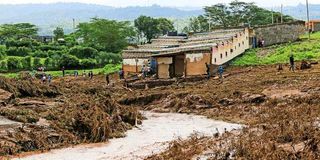Premium
Experts try to make sense of Mai Mahiu tragedy

Water flows past ruins of houses destroyed by water after heavy flash floods wiped out several homes when a dam burst, following heavy rains in Kamuchiri village of Mai Mahiu, Nakuru County, Kenya April 29, 2024.
The flash floods that hit four villages in Nakuru's Mai Mahiu town three weeks ago not only claimed the lives of 61 people and displaced many more but also caused severe environmental damage to the area's ecosystem.
The flood, which originated in the upper Kijabe Hills, stripped the area of all vegetation, leaving once fertile farmlands barren and scarred by gullies.
Farmers in the villages of Kamuchira, Jerusalem, Githioro, Georges and Ruiru are counting their losses after crops and livestock were swept away by the relentless waters.
Experts now reveal that human activities, including cultivation and settlement along the Nyandarua slopes and Kijabe hills, have triggered environmental imbalance, inviting the wrath of nature.
According to Geospatial and Environment Planning expert Prof Simon Onywere, a lecturer at Kenyatta University, the recurring landslides and erosion are a product of deforestation and soil disturbance.
The aftermath of the flooding alters the course of rivers, depositing sediments downstream and reshaping the landscape, Prof Onywere told Nation.Africa.
This ecological upheaval extends beyond physical changes, as exotic vegetation carried by the floods disrupts the area's natural balance.
“When the land is bare the water is able to flow at high-speed carrying with it loose soils and materials which erodes the banks of the rivers. Some riverbanks collapse into the river forming silts which end up blocking the tunnels,” he explained.
According to Prof Onywere, the effect of the flooding is that the rivers will end up defining a new course with materials deposited on the lower side.

Mourners attending the mass service of the Mai Mahiu tragedy.
The upper side of the river will be left rocky with deep gullies, as the lower side gets more silts and other materials, which will be deposited by the flooding waters.
The materials from the mudslides will also carry along exotic vegetation to the lower side, affecting the area's ecosystem.
With the floodwaters reclaiming a 14-kilometre stretch of land, close to 300 metres wide, Prof Onywere warned of future risks, urging residents to prepare for similar disasters.
He also emphasized the importance of allowing scarred landscapes to regenerate naturally, acknowledging the lengthy process of recovery.
The Mai Mahiu flood, in this case, stretched 14 kilometres, covering an area of about 300 metres.
The damaged area, according to Prof Onywere, has now become the river's territory, and the water will always reclaim it anytime there is heavy rainfall.
Tunnels through which the river crosses the roads stand a risk of collapsing due to the heavy materials deposited, which block the tunnel before being deposited on the road.
The expert urged the residents to brace up for more similar floods, with the rains expected to continue pounding.
“No one should settle on the area now that the river has defined its new territory. Wherever the flood waters passed is where it will pass again just as there is a possibility of re-occurrence of the landslides,” explained Prof Onywere.
“Wherever there is a scar of landslide it should be left to regenerate on its own. It will take a long time for vegetation to grow on the land which is bare and rocky,” said Prof Onywere.
Naivasha Sub County Commissioner Mutua Kisila said different state departments are assessing the destroyed installations, including drainage, water and sewerage systems, railway infrastructure and electric installations.
The search and rescue mission, by a multi-agency team, is led by the Rift Valley regional Commissioner, Dr Abdi Mohamed.
He urged the members of the public affected by the floods to move away from the area to allow the team to clear it.
President William Ruto on Tuesday said his government was considering relocating the affected persons from the area.
"We have deployed experts to the affected villages in Mai Mahiu to ascertain if the area is safe for the locals to return. If it turns out that it’s not safe, the movement will purchase land and resettle those whose houses were swept away by raging waters. If it is safe, we will help you rebuild the destroyed houses," said President Ruto.





